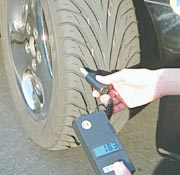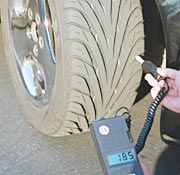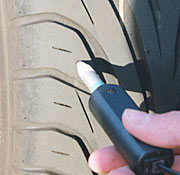Article Topics:
- Overview
- Intro to Racing
- Driving Technique
- Practice Sessions
- Driver’s Gear
- Vehicle Safety
- Handling
- Brakes
- Power
- Tools
TurnFast
recommends
these books:
Articles about Handling
- Chassis Braces
- Wheel Alignment
- Tuning Guide
Car Tire Pressure
Part 1 • Part 2 • Part 3 • Part 4 • Part 5
The Tools
First and foremost, you cannot possibly tune and optimize your tire settings without having the proper tools.
At the very minimum you need an accurate and repeatable tire gauge. Don't cheat yourself with a $3 pencil style gauge. Get a dial gauge, preferably an oil-filled one, with a maximum reading of 50 to 60 psig. It should also have a bleeder valve so you can bleed air from the tire while the gauge is still connected. It's also worth getting the protective rubber case or shell. Dropping a gauge can ruin its calibration, and the rubber shell can prevent that.
To be most effective, you also need a tire pyrometer. You can do a lot with just a pressure gauge, but you'll never be able to quickly and consistently tune the tire pressures without temperature data. Many decent pyrometers are available for a little more than $100. The probe types that penetrate the tires are the preferred ones.
Taking Tire Temperature Measurements
The first rule in taking tire temperatures is that they must be taken when the car comes in from a full race-speed lap. Taking temperatures after a cool down lap is useless. If necessary, the driver should come in a lap early (before the checkered flag) to ensure the tires are race hot. If the driver waits for the checkered flag, chances are he'll get stuck behind slower traffic. The track will be under a no passing rule during cool down, and the tires will cool too much.
Tire temperatures are taken in three places on the tire. First on an outer tread block on a street tire, or about 1" in from the outside edge of a racing slick. Second, in the middle of the tire. Third, on an inner tread block or 1" in from the inside edge of the tire. Often on high performance treaded tires, you'll need to measure the second tread block in from the edge. The outer shoulder block will not retain enough heat for a meaningful reading.
The temperature probe should be inserted all the way in. Whenever taking temps of a treaded tire, be sure to center the probe in the tread block. The edges will cool faster, so it is important to have as much rubber surrounding the probe as possible. Wiggle the probe a little when first pressing it in to ensure it is well seated.
The temperature reading will fluctuate for several seconds. Do not wait for it to be perfectly stable. As soon as it settles to within a couple of degrees F, take the reading and move on. You shouldn't have to wait more than 5 seconds for each reading.
Always measure each tire in the same pattern. Whether it's inside, center, outside, or the other way around doesn't matter. Just do it the same way every time.
Be consistent in the tire sequence also. Generally, you'll want to measure the hottest side first to be sure they're not overly heated. For example, if the entry to the pits is after a series of long right turns, measure the left tires first. Whatever the sequence, be sure to repeat it with every reading.
We'll cover how to interpret the readings in following articles.
Tags: Race Tires, Performance Tires, Car Tires, Portable Air Compressors, Tire Gage, Tire Temperature
Article subsections:
Part 1
- Introduction
Part 2
- tools
- taking temp measurements
Part 3
- starting somewhere
- fine tuning
Part 4
- adjusting for ambient temperature
- optimizing tire performance
- optimizing tire temperature
- optimizing contact patch
Part 5
- road racing vs. auto-crossing
- stock front-drive cars




When taking tire temperatures, take 3 readings from the outside, middle, and inside of the tire. As shown in the photo immediately above, be sure to insert the probe in the center of the tread block when measuring treaded tires. This can be tricky with tread blocks of irregular shapes like this tire shown. The goal is to get a roughly equal amount of rubber around the probe.
